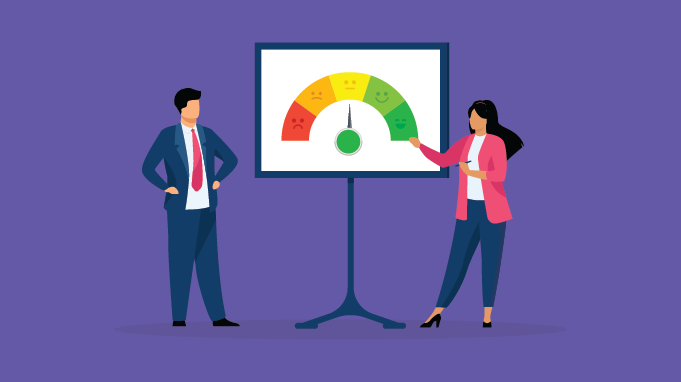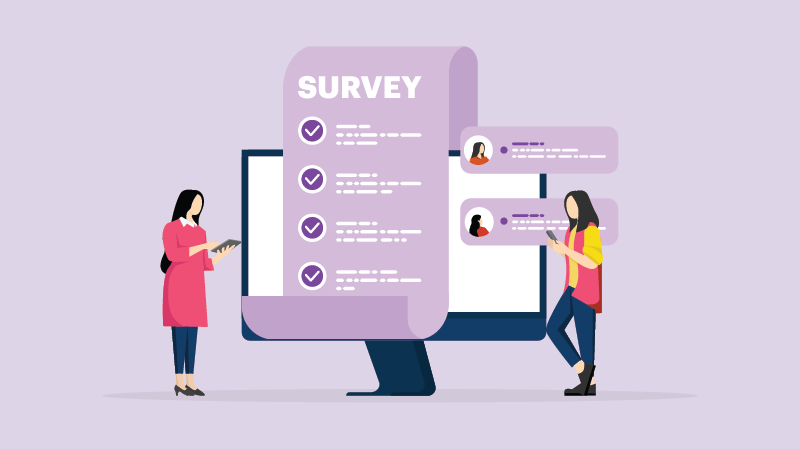Employee Satisfaction Survey : 40 Effective Questions,Benefits and Examples
In the ever-evolving landscape of building a thriving workplace, the happiness of your employees stands as a cornerstone. However, as workplace dynamics evolve and the needs of today's workforce vary greatly, understanding the level of satisfaction among employees becomes crucial. This is where employee satisfaction surveys come into play, serving as a pivotal tool for organizations.
In this detailed guide, we'll delve into the essentials of crafting an impactful employee satisfaction survey. We'll discuss its significance and provide a step-by-step approach to conducting it effortlessly. But before we dive into the details, let's take a brief look at the key takeaways from the blog.
Key Insights
- Concept Of Employee Satisfaction And Its Importance
- Concept Of The Employee Satisfaction Survey
- What Are The Benefits Of Conducting Employee Satisfaction Surveys?
- How To Plan an Employee Satisfaction Survey?
- How To Analyze And Take Action After Conducting An Employee Satisfaction Survey?
- Best Practices For Conducting An Employee Satisfaction Survey
What Is Employee Satisfaction And Why Should We Measure It?

Employee Satisfaction is a measurement of an employee’s “happiness” with current job and conditions.
– ADP Research Institute
Employee satisfaction refers to employees' overall contentment and happiness toward their jobs and work environment. It encompasses satisfaction from pay and benefits to organizational culture, work relationships, growth opportunities, and more.
Monitoring employee satisfaction provides valuable insights into how satisfied versus dissatisfied workers perceive the workplace. This allows organizations to identify problem areas and gaps in meeting employee needs. Measuring employee satisfaction ensures employees feel valued, engaged, and dedicated to the company's success.
As per a recent report by CNN Business, US employees’ job satisfaction overall is the highest it has ever been since the survey began in 1987.
What Is Employee Satisfaction Survey?

Employee satisfaction surveys are structured questionnaires or sets of questions designed to assess how content and fulfilled employees feel across all aspects of work.
From company culture to manager relationships and everything in between, these surveys provide a meticulous analysis of the employee experience.
Regular satisfaction surveys, whether monthly, quarterly, or annually, offer a reliable pulse check on your organization.
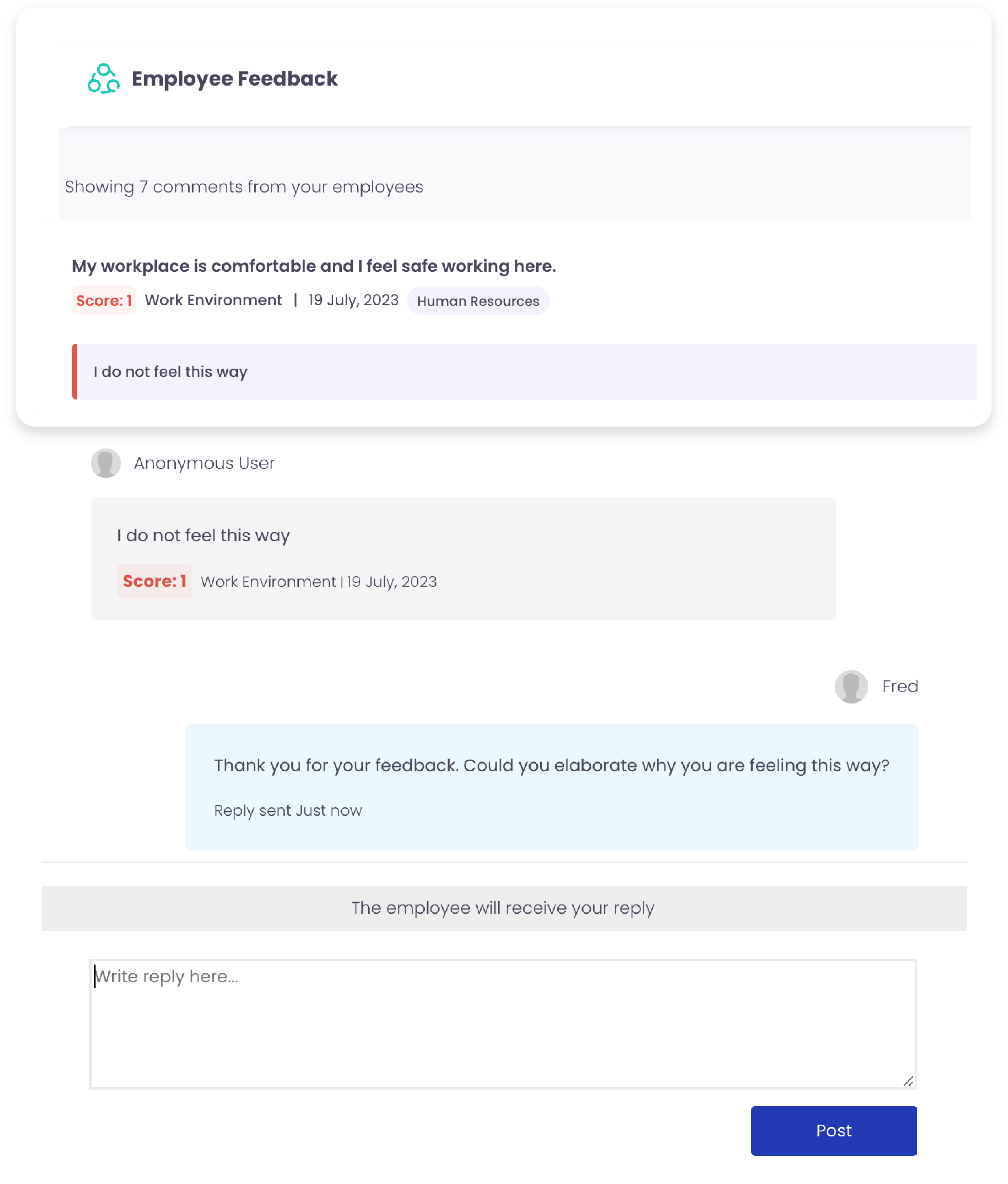
Source: Vantage Pulse
The image above illustrates how employee satisfaction survey tools enable you to understand the satisfaction level of your employees and resolve issues by getting to the bottom of the problems.
Benefits Of An Employee Satisfaction Survey

- A company’s culture is said to be the sum of the behavior of its people. Satisfaction surveys offer meaningful data that can help you understand the dynamics of the company culture.
- These surveys create organizational awareness by addressing the critical as well as minor issues of the workplace.
- Employee satisfaction surveys are the best way to track and benchmark employee satisfaction within the industry. It is a great way to ensure the company aligns with industry standards in offering employee perks and benefits.
- Running regular surveys to understand employees’ satisfaction levels presents a caring image of the company. Employees feel empowered, and it boasts a much-needed culture of continuous improvement.
- Another advantage of employee satisfaction surveys is that it spreads positive word of mouth. Happy employees advocate positive vibes through social media, review websites, polls, etc.
How To Plan An Effective Employee Satisfaction Survey

Planning an effective employee satisfaction survey is essential for gathering meaningful insights that can drive positive changes within your organization. A well-planned survey helps identify areas where employees are satisfied while also highlighting areas for improvement, ultimately leading to a more engagement .
In the planning phase, you lay the groundwork for the entire survey process. This involves defining objectives, selecting appropriate survey methods, designing relevant questions, and ensuring confidentiality and anonymity to encourage honest feedback.
But the question is, how do you get started with your employee satisfaction survey? You need to have a strategic plan first. And that involves asking a few questions -
- Are you trying to reduce employee turnover in a certain department?
- Are you trying to gain insight into remote employee challenges?
- What specific issues do you want to uncover?
- Should participation be voluntary or mandatory?
These questions will help you in planning an effective employee satisfaction survey. Typically, a plan like this involves multiple steps. Let’s see what they are -
1. Identify Goals
Determine the key things you want to learn from the survey, such as sources of dissatisfaction, engagement levels, retention risks, etc. Your goals also determine appropriate survey frequency - quarterly for a pulse check versus annually for a broader assessment. Keep the goals focused for a survey that yields actionable insights.
2. Create Survey Questions
With goals framed, develop 10-15 questions to reveal related insights. Use a mix of question types - satisfaction ratings, agree/disagree statements, multiple choice, and open-ended to create the perfect employee satisfaction survey questionnaire. Review existing questionnaires for inspiration but customize them to your goals. Allocate the majority of questions to your 2-3 priority focus areas for sufficient related data.
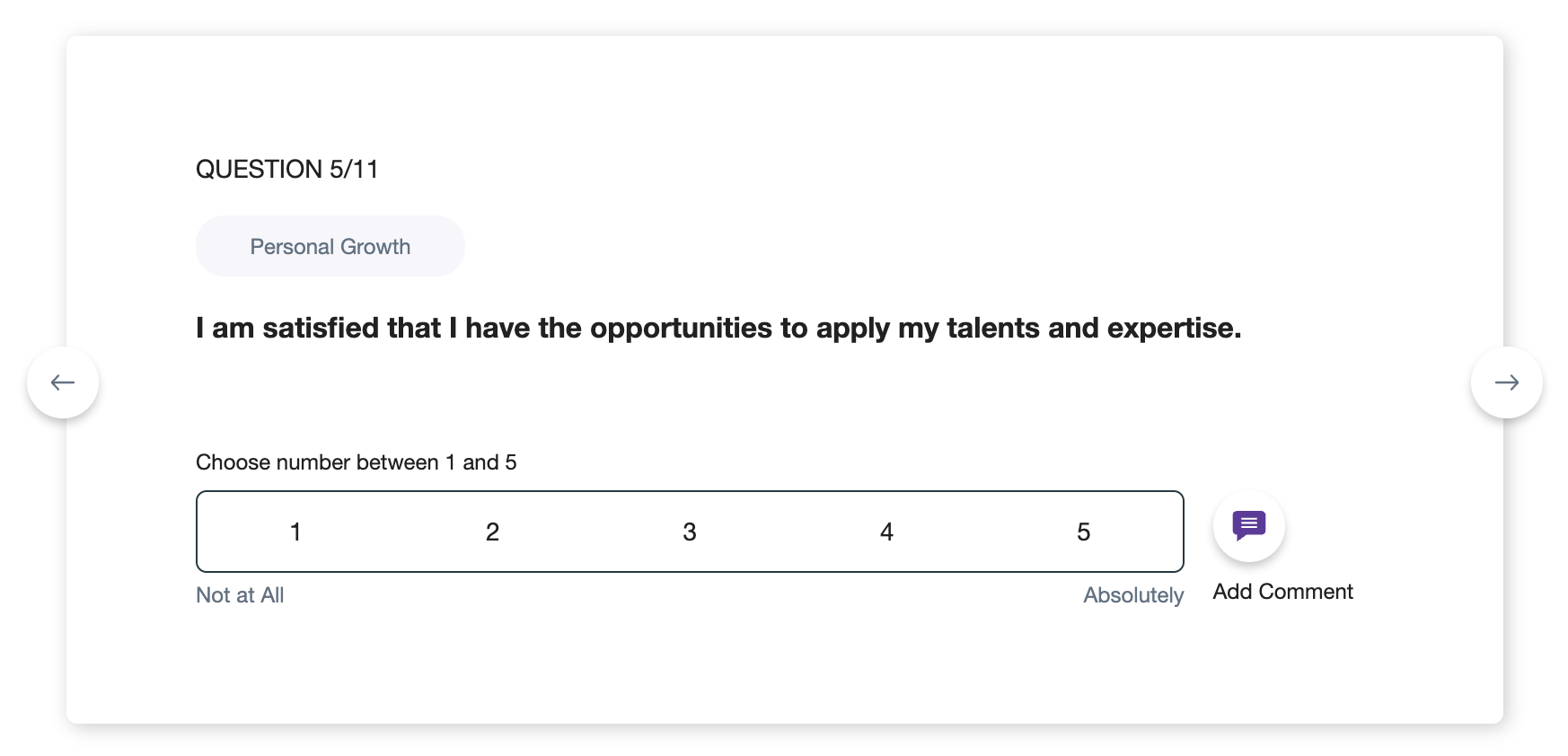
Source: Vantage Pulse
3. Choose Survey Method
Select the best method, such as an online survey, paper, kiosk survey, interviews, etc, based on your workforce.
4. Determine Audience
Decide if all employees will participate or only specific teams, roles, levels, demographics, etc. Do not ask for names or identifiable info to encourage honest feedback. Inform your employees in advance and communicate the purpose of your survey.
5. Check Survey Length
Keep the survey focused at 10-15 minutes maximum to avoid survey fatigue. Measure the time required to complete when piloting. Remove or condense unnecessary questions to respect employees' time. Long surveys lead to poor-quality data due to rushed or abandoned responses.
6. Test The Survey
Pilot the survey with a small test group to identify flaws before the full launch. Check for unclear wording, ideal order/flow, technical glitches, and projected completion time. The test group can provide input on adding or removing questions. Refine the survey based on feedback before distributing company-wide.
7. Select Distribution Method
Choose the best communication method for sharing the survey based on your workforce makeup and culture. Email, internal portals, or messaging platforms are solid choices. Printed forms may suit some environments. Ensure the selected method is the most convenient and effective for increasing participation.
8. Set A Timeline
Schedule start and end dates thoughtfully, avoiding conflicts with other surveys or peak workload periods that lower participation. Allot 1-2 weeks for responses, with extensions if needed to improve response rate. Advance communication of timelines helps employees plan for completing the survey amidst their responsibilities.
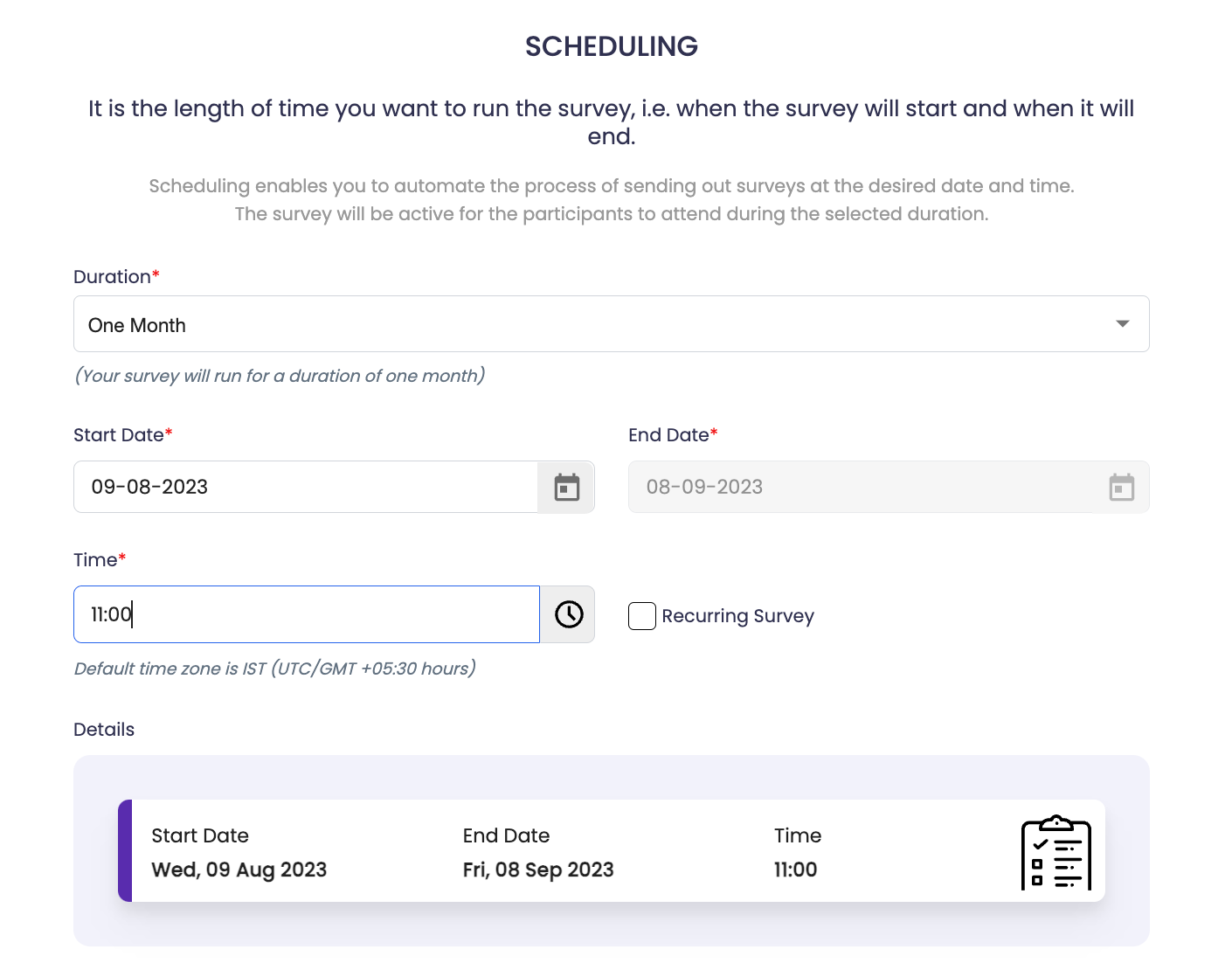
Source: Vantage Pulse
Related Article: How to Design an Employee Survey:Best Practices and Tips
h40 Examples Of Employee Satisfaction Survey Questions Based On Different Categories

Employee satisfaction surveys can help you uncover the lesser-known or ignored factors leading to employee dissatisfaction. Therefore, choosing the right survey questions is crucial to get the most out of your employee surveys.
To make it easier for you, we have curated a category-wise list of employee satisfaction survey questions in the eNPS format that focus on gathering employee feedback regarding various aspects of their job, workplace, and overall work experience.
Questions are presented along with a scale, where the employee can choose the appropriate response from a scale of 1 to 5. In this scale, 1 = Strongly Disagree, 3 = Neutral, and 5 = Strongly Agree.
Company Culture
A positive culture fosters collaboration, recognition, and a sense of belonging. In contrast, a toxic culture breeds stress, mistrust, and disengagement, undermining job satisfaction and well-being.
Here’s a list of employee survey questions you can ask your employees to promote a positive company culture:
- On a scale of 1-5, how likely are you to proudly recommend the company to your friends and family?
- On a scale of 1-5, how strongly do you feel your values align with the company's values?
- On a scale of 1-5, how would you rate your organization's commitment to creating a safe and supportive work environment?
- On a scale of 1-5, how actively does your company promote diversity, inclusivity, and belonging?
- On a scale of 1-5, how actively does the company encourage teamwork and collaboration?
- On a scale of 1-5, how transparent is your organization is about its policies and rules?
- On a scale of 1-5, how openly does your organization embrace new ideas, opinions, and innovations?
Job Satisfaction
Job satisfaction is an intricate concept representing the emotional and psychological state of fulfillment an employee experiences in their work role. It reflects the individual's expectations, needs, and aspirations.
Below, you'll find a compilation of employee survey questions that delve into the realm of job satisfaction within your workforce:
- On a scale of 1-5, how closely do your current roles and responsibilities align with the job description you received?
- On a scale of 1-5, how often do you leave work with a sense of achievement and satisfaction?
- On a scale of 1-5, how likely are you to continue working with this organization for the foreseeable future?
- On a scale of 1-5, how satisfied are you with the challenge and complexity that your job demands?
- On a scale of 1-5, how strongly do you feel a sense of purpose in your job?
- On a scale of 1-5, how manageable do you consider your workload to be?
- On a scale of 1-5, how excited are you to come to work every day?
- On a scale of 1-5, how frequently does your company seek employee feedback to improve the work experience?
A Zippia research concluded that 65% of U.S. workers are happy with their job. But only 20% are passionate about their jobs. Likewise, only 49% of American workers report being “very satisfied with their work,” while 30% are “somewhat satisfied.”
Professional Growth
Professional growth opportunities play a pivotal role in employee satisfaction by fostering a sense of engagement, motivation, and purpose. When employees have access to continuous learning, skill development, and the chance to advance their careers, they feel valued and invested in their organization's success.
Below is a compilation of survey questions exploring professional growth within your workforce:
- On a scale of 1-5, how satisfied are you with the variety and relevance of training courses offered by the company?
- On a scale of 1-5, how well do the professional development workshops provided by the company align with your career goals?
- On a scale of 1-5, how clear is the company's communication about potential career paths and the training required to reach them?
- On a scale of 1-5, to what extent are you able to apply the skills and knowledge gained from the company's training programs in your current role?
A 2023 Linkedin report shows that 94% of employees would stay with a company longer if the organization invested in learning.
Manager-Employee Relationship
The manager-employee relationship profoundly shapes employee satisfaction. A positive and supportive relationship fosters open communication, mutual respect, and a conducive work environment.
Here is a list of survey questions for employees that explores the manager-employee relationship within the workforce:
- On a scale of 1-5, how would you rate your manager's willingness to listen to your ideas and concerns?
- On a scale of 1-5, how frequently does your manager provide feedback that directly helps you improve your specific skills and performance?
- On a scale of 1-5, how well does your manager celebrate your individual achievements, both in private and in front of the team?
- On a scale of 1-5, how supportive is your manager when you face challenges?
- On a scale of 1-5, how fairly and effectively does your manager handle interpersonal conflicts within your team?
- On a scale of 1-5, how confident are you in your manager's ability to guide and lead the team toward common goals?
According to McKinsey, Workplace relationships account for 39% of employees’ job satisfaction, and relationships with management, particularly, account for 86% of workers’ satisfaction with their interpersonal ties at work.
Compensation and Benefits
Compensation and benefits are an integral aspect that influences employee's job satisfaction.
Competitive and fair compensation, including salaries, bonuses, and incentives, provides employees with financial security. At the same time, comprehensive benefits such as health insurance and retirement plans address employees' personal needs by providing a safety net.
Presented below is a compilation of survey questions aimed at eliciting insights from employees regarding compensation and Benefits within the workforce:
- On a scale of 1-5, how satisfied are you with your current compensation package?
- On a scale of 1-5, how fairly do you think you are paid compared to your coworkers in similar roles?
- On a scale of 1-5, how satisfied are you with the retirement/pension plan?
- On a scale of 1-5, how adequate is the annual paid time off provided by the company's policy?
- On a scale of 1-5, how satisfied are you with the current healthcare benefits?
- On a scale of 1 - 5, how comfortable do you feel discussing compensation and benefit matters with the company's HR?
- On a scale of 1-5, how consistent is your employer in offering performance-based incentives?
- On a scale of 1-5, how satisfied are you with the company's ESOP or stock options program?
Work-Life Balance
Work-life balance is crucial for employee satisfaction as it ensures that individuals have the time and energy to fulfill both their professional responsibilities and personal pursuits.
Here’s a list of employee satisfaction questions that helps measure the work-life balance of the employees in the workplace:
- On a scale of 1-5, how often does your employer take actionable steps to reduce workload during particularly intense or stressful periods?
- On a scale of 1-5, how open is your employer to offering flexible work arrangements (such as remote work, flextime) to enhance work-life balance?
- On a scale of 1-5, how frequently does your employer actively promote the utilization of paid time off, vacations, and breaks to ensure rest and recuperation?
- On a scale of 1-5, how responsive is your employer to individual requests or concerns regarding adjustments needed for better work-life balance?
- On a scale of 1-5, how consistent is your employer in respecting non-working hours by avoiding unnecessary intrusions into personal time?
- On a scale of 1-5, how well does your employer align workload and deadlines with realistic expectations, considering the human aspect of work-life balance?
- On a scale of 1-5, how often does your employer engage in discussions or solicit feedback regarding work-life balance improvements?
A Study by Randstad shows that approximately 94% of employees consider work-life balance important.
Analyzing And Acting On Survey Results

Now that you know how to create a survey, the next step in the process is to analyze the data gathered from the survey. This survey data should be prepared for review once gathered.
1. Review Survey Data
The first step is to look at the overall response rate. What percentage of employees who received the survey actually completed it? Always aim for a 30-40% minimum response rate for valid insights. If the response rate is lower than that, it could mean your data is skewed and not worth analyzing.
Low response rates signal that the survey may need to be redone. It also indicates that communication has to be improved within the organization to convey the importance of the survey.
2. Segment Survey Data
Once you have completed reviewing the survey data, you must Break down survey responses by department, location, role, seniority level, or other demographic factors. Look for trends in satisfaction scores or feedback from certain employee segments. This identifies if dissatisfaction concentrates on one group.
3. Quantify The Data
Assign numerical values to each rating option for survey questions that use a satisfaction rating scale (e.g., 1-5 or 1-10). Then calculate average satisfaction scores for each rating question. This helps quickly identify areas with particularly high or low average satisfaction. Low-scoring areas pinpoint where employees are most dissatisfied.
4. Analyze Qualitative Data
Well-constructed surveys include some open-ended questions or comment boxes to gather qualitative insights. Review all comments and categorize them into common themes around issues, challenges, suggestions, and sentiments. The themes help reveal larger trends across the open-ended feedback.
5. Visualization Of Data
Convert survey data into visual charts and graphs to simplify analysis. Pie charts work for rating questions. Bar or column graphs display segmented data. Heat maps visualize satisfaction ratings.
6. Review Insights And Take Action
Discuss survey results with leadership, managers, and employees for their perspectives. This collaborative approach enriches understanding of the issues uncovered in the survey.

Source: Vantage Pulse
Using insights gathered from the survey analysis, and review discussions, outline specific steps your organization can take to address problem areas. Turn feedback into actions to improve policies, communication, employee experience, and satisfaction.
Common Challenges Faced During Satisfaction Survey

Survey Fatigue:
survey fatigue is real, and it is often the main reason behind low response rates. Survey weariness happens when:
- Surveys are too long
- The questions are very vague and irrelevant
- The motive behind the survey is not clear
The number one driver of survey fatigue is the perception that the organization wouldn’t act on the results.
– Mckinsey
Low Response Rates:
It's frustrating when only a small percentage of employees complete the survey, skewing results. This happens due to -
- Poor communication
- Survey fatigue
- Lack of trust
Promote the survey through multiple channels, explain the valuable role of feedback, keep it concise, and ensure anonymity. Consider incentives for responding. Follow-up with non-responders to increase participation.
Time-Consuming:
Employees are most likely to respond to a survey during work hours. You must ensure that it doesn’t take up much of the time from their already cramped schedule. It is for the best if the survey is online and they land directly in their inboxes.
Frequency Of The Survey:
Timing and frequency are critical factors in running a survey—running surveys once a year is a bad idea. Instead, you should spread the survey over the period. Improving the frequency and making surveys a regular part of the culture will ensure maximum success.
Lack Of Anonymity:
Employee satisfaction surveys, especially, should be made anonymous. What makes an employee satisfied or dissatisfied at work are often personal factors. They would most likely not like to share it unless confidentiality is ensured.
Inaction Of The Management:
Surveys are often ignored because management doesn’t take the necessary actions on the results. Before you rush to run your survey, make sure that you have an action plan and are ready to implement changes.
Unclear Communication:
Make it a point to share a summary of the critical results once the data are in. Also, communicate the successes after implementing employee-led ideas. This will reinstate the trust among employees, and they will stay engaged in future surveys.
Recommended Resource: A Brief Guide On Employee Pulse Surveys
Employee Engagement Survey Vs. Employee Satisfaction Survey
| Criteria | Employee Engagement Survey | Employee Satisfaction Survey |
|---|---|---|
| Goal | Assess employees' enthusiasm and commitment to their work and the organization. | Gauge employees' happiness and contentment with their jobs and the workplace. |
| Metrics Measured | Energy, involvement, connection to the company's mission and values. | Satisfaction with compensation, benefits, work-life balance, management, etc. |
| Data Analysis | Identify engagement drivers and problem areas. Segment by demographics. | Pinpoint sources of dissatisfaction. Track trends over time. |
| Outcomes | Strengthened employee-employer relationship, retention, innovation, performance. | Enhanced workplace happiness, reduced turnover, attraction of top talent. |
| Actions Taken | Improve leadership, communication, career development, workplace culture. | Reform policies, management, benefits, work environment issues. |
Recommended Resource: Ultimate Guide On Employee Engagement Surveys
Finally
In the big picture of making your company great, keeping your employees happy is like planting the seeds of success. When you look at your Employee Satisfaction Survey feedback, you're holding a treasure map to a happier and more successful team. Each response is like a clue that can lead to better teamwork, more work getting done, and a workplace where everyone feels good.
We hope this guide gives you a better overview of designing an effective employee satisfaction survey and getting the most out of them.
Are you running these surveys in your organization? If not, you should start right now. If yes, then do drop us an email. We'd love to include your suggestions on this blog.
FAQs

What is the ideal frequency for conducting employee satisfaction surveys?
Most experts recommend conducting frequent satisfaction pulse surveys. Gathering regular feedback based on a steady stream of data enables continuous improvement.
How do we encourage participation in surveys?
Encourage participation in surveys by reducing survey fatigue and through gamification of the surveys. Explain to your employees how results will be used to drive improvements.
What incentives can we offer employees for completing surveys?
Small incentives like gift cards, reward points, or monetary incentives help boost participation. Monetary incentives can be provided through the gamification of the surveys. For example, you can offer online scratch cards to participants that contain monetary amounts ranging from $0 to $100.
Should managers see their team members' individual responses?
No, individual responses should always be anonymous to encourage honest feedback. Only aggregated team-level data should be visible to managers.













